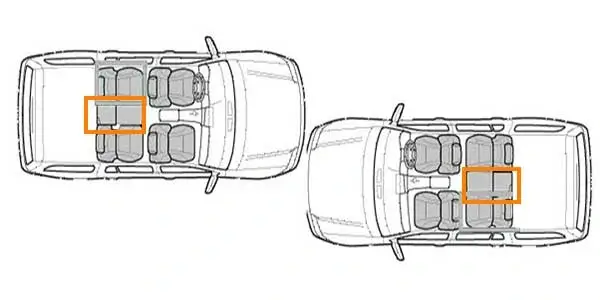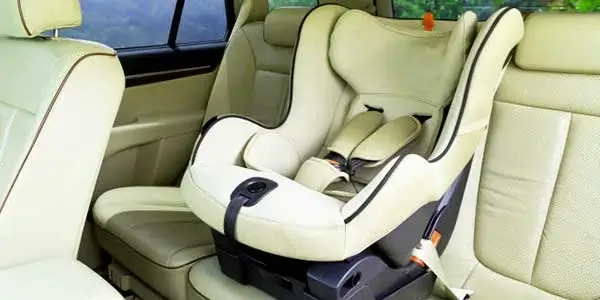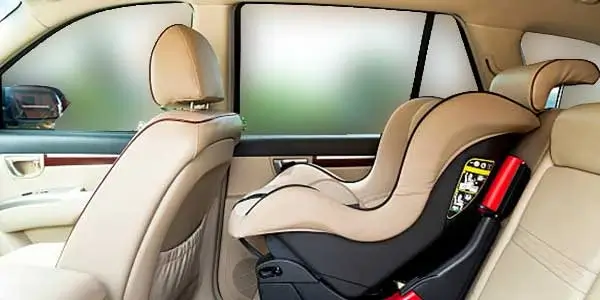There are numerous considerations that need to be made while buying a car seat for your child. It must not only adhere to state laws and regulations, but it must also be appropriate for your child’s size and age range. Furthermore, it is crucial that you correctly install the child’s car seat. Additionally, you must be aware of the location in your car that is the safest, and if you have two young children, you must be skilled at organizing the installation of two children.
Why Proper Car Seat Placement in an SUV is Critical for Your Child’s Safety
The use of car seats for children’s safety in moving vehicles is unquestionably a crucial component of ensuring their well-being. The likelihood of injuries or fatalities occurring as a result of vehicle accidents is greatly reduced when these seats are used.
Rear-facing (for infants and toddlers), forward-facing (for children 2 to 7 years old), and booster seats (for children 8 to 12 years old) are the three different types of seats available.
Choose a car seat that is compatible with your vehicle, has a solid connection method, and offers sufficient side impact and head protection. It is crucial to avoid using car seats that have either been recalled or are deemed out-of-date.
You have the option of using the LATCH system or the seat belt system when installing car seats. To ensure the installation process is carried out correctly, it is crucial to closely follow the manufacturer’s instructions.
Factors to Consider When Choosing the Safest Place for Your Car Seat in an SUV
When choosing the safest location for your car seat in an SUV, keep the following things in mind to protect your child.
-
The size, shape, and design of the vehicle must be taken into account first.
An SUV’s massive size and intricate design can be somewhat perplexing. The location of the vehicle seat’s safety can be considerably impacted by its size and design. The best location for the car seat depends on the shape of the seat, the angle of the backrest, and the space between the front and back seats.
-
Next, you need to think about the kind of car seat you have.
Where a vehicle seat can be safely installed in an SUV will depend on the model. A forward-facing car seat should be positioned differently from a rear-facing one. The location of a convertible car seat is also possible. The child’s age, height, and weight will make things more difficult.
-
The third factor to take into account is the necessary quantity of car seats.
If you have more than one child, you must establish the best position for each car seat. You might have to look for a different SUV or car seat entirely.
-
Fourth, you must evaluate the SUV’s safety features.
The position of the car seat can be impacted by the SUV’s safety standing, airbag placement, and other safety measures. It’s crucial to comprehend the safety features of the SUV and how they affect where the car seat should be installed.
-
Eventually, you must take into account your personal preferences and circumstances.
The Suv seat ideal location may not be the most convenient or accessible one. You must choose the fashionable compromise between convenience and safety.
6. In conclusion
Choosing the safest location for your child’s seat in an SUV necessitates a significant amount of thought and analysis. It can be a difficult undertaking because of the complexity and bustiness of the contributing components. The size, form, and design of the vehicle, the kind of auto seat, the required number of auto seats, the SUV’s safety features, as well as your personal tastes and way of life, must all be properly estimated.
Safest Spots for Car Seats in SUVs
The safest spot for a seat is still in a minivan or SUV, and it should be installed in the center of the middle row. If your vehicle has a middle-row bench. Again, if your middle row has bucket seats, you should put the seat in the third row.

1. Middle of the Back Seat: Why It’s Considered the Safest Spot for Your Car Seat

The middle seat is the furthest away from the impact during a crash, as well as the furthest down from airbags. The National Highway Traffic Safety Administration (NHTSA) recommends that all children under the age of 13 left in the aft seat, perfectly in the center. The rear center seat is also advised as an appropriate location for children’s car seats. According to the AAP, children in the back center seat are 43 percent less likely to be injured than children in the back window seats.
2. Rear Passenger
Consumers frequently favor this posture even though studies indicate that it is not the safest car seat position.
The rear passenger seat has the benefit of allowing you easy access to your child because the child safety harness is frequently on the vehicle’s pavement side, away from the direction of traffic.
3. Rear Driver
The fact that the car seat is in the back of the vehicle means that it is still in a secure area. However, because it is a more frequent side of contact, it is less safe than the rear passenger.
4. Front Passenger
While it is advised that you keep your child in the back seat, if for any reason you must place them in the front passenger seat, make sure the front airbags are always deactivated before driving. Never put a youngster under the age of 12 in a seat with a passenger airbag.
Due to the higher danger of driver attention and proximity to the most frequent side of impact, being in the front should only be done as a last resort. If a family has three children (a baby, a toddler, and a 4-year-old) and three seats couldn’t fit along the back, we advise placing:
- The infant in the back passenger seat
- The little child behind the steering wheel
- With the front seat at the backmost position and the airbags disengaged, the 4-year-old was properly restrained in the front passenger seat.
Choosing the Right Car Seat for Your Child’s Age and Size
For Further Explanation as per the child age and what position would be the best. Here is a few recommended positions to ensure maximum safety of your child.
- Birth- 12 Months
Your child under age 1 should always ride in a rear-facing auto seat
- 1 – 3 years
Keep your child rear-facing as long as possible. It’s an appropriate way to keep him or her safe. Your child should remain in a rear-facing auto seat until he or she reaches the top height or weight limit allowed by your auto seat’s manufacturer. Once your child outgrows the rear-facing auto seat, your child is ready to travel in a front-facing auto seat with a harness and tether.
- 4 – 7 years
Keep your child in a front-facing auto seat with a harness and tether until he or she reaches the top height or weight limit allowed by your auto seat’s manufacturer. Once your child outgrows the front-facing auto seat with a harness, it’s time to travel in a supporter seat, but still in the aft seat.
- 8 – 12 years
Keep your child in a booster seat until he or she is tall enough to wear a seat belt properly. The seat belt must tie tightly across the upper shanks, not the stomach, for a seat belt to fit properly. The shoulder belt should be snugly fitted across the shoulder and casket, avoiding crossing the neck or face. In the past, your child should still ride in the back seat since it is safer.
Rear-Facing Car Seat Placement in an SUV: A Comprehensive Guide
INSTALLING THE CAR SEAT BASE WITH A SEAT BELT
- Read the instructions for both your vehicle and your bus seat.
- Pay special attention to the directions on how to “lock” your seat belt and the seat belt system information.
- Every seat and vehicle are different, which influences how you install your specific seat.
- The bus seat base should now be in the rear seat of your car.
- Thread the seat belt precisely through the belt path that faces the hamper.
- Check the seat belt for straightness and twists.
- Put on your seatbelt.
- Firmly press down on the bus seat’s base.
- From side to side or front to back, the base should not move more than an inch.
- Ascertain that the base of your car seat is installed with the proper slope of inclination.
- Infants must travel sitting and slightly inclined to keep an unobstructed airway.
Forward-Facing Car Seat Placement: How to Choose the Safest Spot
- Since the tether anchor reaches above the car seat.
- Any vehicle manufactured after 2003 will have three of these tether anchors, and you should consult your owner’s manual to find out where they are.
- Place the tether anchor in place, then tighten it. Insert the seat belt through the belt passage, lock it, and tighten it.
- Instructions on how to do this properly can be found in the car seat and vehicle manuals.
- Once you’re finished, the car seat should not move more than one inch from side to side or front to back on the belt path. If you’re using a convertible car seat, the belt path may differ depending on whether the seat is facing forward or backward.
Booster Seat Placement in an SUV: Tips to Ensure Optimal Safety
- Install the booster seat according to the instructions in your vehicle owner’s manual and the booster seat product manual.
- Place the booster seat in the back seat, facing forward. It’s best to put it in the middle of the back seat.
- Ensure that the lap belt is level, low, and snug across your child’s hips, and that the shoulder belt is flat and snug across their shoulder, not touching their neck or face.
- If your child straps themselves in, double-check that they have done so correctly.
- To ensure that the booster seat is properly installed, take it to a child safety inspection station.
Ensuring Maximum Car Seat Safety in Your SUV
- Find the best car seat
- Learn about the four types of car seats and follow the NHTSA’s car seat recommendations based on your child’s age and size.
- Install your car seat correctly
- Understand the parts and advice required for installation
- Follow our extensive car seat installation instructions and videos.
- Get your car seat examined at a station near you
- Keep your child secure with a car seat
- Register your car seat and sign up for recall notices to receive safety updates
Installing Your Car Seat Correctly in an SUV: Tips and Tricks
- Go to a Checkup Event.
Safe Kiddies coalitions have auto seat scan events and examination stations around the country.
- Find an Expert
Find an Expert. If there isn’t an event near you. Look for a certified Child Passenger Safety Technician who can help you.
- Find the Best Place in the Vehicle:
The best seat is the back seat. It’s the safest place to ride for all children under age 13.
- Find the best position:
Not all cars and SUVs allow for an auto seat in every place that has a seat belt.
Check your auto proprietor primer to see where you can safely put an auto seat.
- Consider every passenger.
Make sure that the auto seat or supporter seat for each child riding in the auto is in the most stylish possible place. Also, make sure other passengers in the auto can ride safely, too.
- Use the Seat Belt or LATCH:
There are two ways to secure an auto seat in a vehicle. Both are safe but don’t use both at the same time.
- Seat belt:
Place the seat belt through the auto seat at the belt path. Look for arrows and directions on the auto seat marker to show you the correct belt path to use. Use the top tether on all forward-facing auto seats.
- LATCH:
That stands for lower anchors and tethers for children. Auto seats have lower attachments that connect to the auto’s lower anchor bars. Use the top tether on all forward-facing auto seats.
- Get a snug fit:
Do the Inch Test. A duly- installed auto seat shouldn’t move more than one-inch front to back or side to side when pulled at the seat belt path. This rule applies for forward-facing auto seats and hinder-facing auto seats and when the seat is secured with either the seat belt or LATCH. The top tether makes your forward-facing auto seat redundant and snug. Use it every time
Regular Car Seat Checks and Maintenance: What You Need to Know
Once the auto seat is installed, you still, we need to make sure it’s still duly installed and used rightly on every lift. Then are many quick tips that can help ensure your child’s auto seats are ready to work.
- Check for Movement
Every time you use the auto seat, make sure that the seat is still rightly installed and duly fits the child who’s riding in it. Right before you load your child into the seat, give the auto seat a quick handshake at the belt path to confirm that the installation is still secure.
- Check for the Correct Rear Facing Recline Angle
For hinder-facing auto seats, take a look at the recline angle is the seat still installed at the right angle according to the manufacturer’s guidelines and your child’s age? While the angle might be correct when you first install the seat that could change over time. It’s worth an alternate look every now and again.
- Check the Vehicle Seat Belt
When your auto seat is installed with the vehicle seat belt, peep at the seat belt to make sure it’s still secured.
- Tug on the Top Tether
While you’re doing your routine auto seat checks, cast an eye at the tether for any forward-facing auto seat and corroborate that it is still duly attached, tensed, and not interacting with any of the stuff in your box.
- Periodic Checks are Important
Auto seats are made to be used daily, that’s their job. While doing that veritably important job, they get a lot of use. Uninstalling and examining your child’s auto seat when it’s outside of the vehicle from time to time gives you an occasion to look them over for damaged, and lost toys, and to prize numerous, numerous motes from the seat.
Pro Tip: Turn the auto seat upside down to unleash a small shower of retired snacks and toys
Conclusion: Keeping Your Child Safe in an SUV
- Children must be properly restrained at all times when traveling in a vehicle.
- Make sure you choose the suitable restraint for your youngster and your car; conditions must be properly fitted and used.
- Traveling with children can be difficult, but there are things you can do to make the journey smoother and safer.
- Only move children to the next order of restraint when they have outgrown their current restraint.
Final Thoughts on Choosing the Safest Place for Your Car Seat in an SUV
- You’ve chosen a safe auto seat for your children and are now ready to go on a family road trip!
- Before you go off, it’s critical to understand how to properly position your car seat.
- We propose that you install your auto seat in the back seat rather than the center.
- However, if you have a lot of auto seats to install or your vehicle isn’t designed for center placement,
- you may need to look into other options.
FAQs
Is the middle seat the safest for a car seat?
Because of its maximum distance from passenger-side airbags and any implicit collision, the rear middle seat is the safest spot for your auto seat.
Why is the seat behind the driver the safest?
The anterior controlled crumple zone naturally receives the first surge of impact. As a result, the forces acting on the rear of the vehicle cabin are dampened, reducing the threat of serious injury
Should car seat go behind driver or passenger?
The auto seat should always be installed in the aft seat. That’s the safest spot for your baby. However, put the auto seat in the center seat, If you can. However, it’s fine behind either the motorist or passenger side, If not.
Can you put a car seat in the third row of an SUV?
Still, the answer is yes, if you are wondering if you can put an auto seat in the third row of an SUV. But space limitations can make it difficult to get the seat installed duly and maneuver with a child
Where is the least safe place to sit in a car?
According to the Insurance Institute for Highway Safety (IIHS), if you ride in the backseat of a car without breaking a seatbelt, you are eight times more likely to be injured or killed in a crash than if you are wearing a seat belt.
My Cars Laws >> Seat Laws >> Guide >> Choosing the Safest Place for Your Child Car Seat in an SUV

